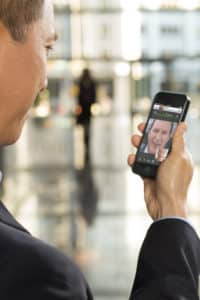
In healthcare, mobile devices are being used to improve both operational efficiency and the quality and speed of care. On the most basic level, clipboards and pens are being replaced with tablets so data can be collected at the point of care and accessed by all who need it from any location. This streamlines workflows, reduces the risk of errors, and keeps providers informed about patient conditions so they can make better, faster decisions. Less time is spent on data entry and phone tag, and more time is spent caring for patients.
Monitoring devices can alert doctors to potentially dangerous health risks so patients can be treated before their conditions worsen. Doctors can evaluate patients remotely, using images and video to diagnose and recommend treatment for various conditions. Mobile applications can also provide patients with fast, easy access to their medical records, as well as instructions from their doctors.
As healthcare organizations embrace mobile, communication and collaboration should be among their top priorities. According to the 2016 Enterprise Mobile Apps Report by Edelman Intelligence and Adobe, 55 percent of organizations say that the “need for instant communication” is driving their investments in mobile apps. Additionally, 57 percent said that messaging and collaboration apps are mission-critical today, with 59 percent saying those apps will be mission-critical in three years.
However, if messaging and collaboration apps aren’t fully integrated into the corporate communication infrastructure, users will feel disconnected and the organization won’t maximize its investments in mobile. Busy healthcare environments in particular need one mobile app that puts full-featured communication tools at users’ fingertips.
ShoreTel’s mobility app delivers all the productivity enhancing features of ShoreTel Connect to iOS and Android devices. Healthcare providers can make and receive calls from any location through a single number without giving out their personal mobile number to colleagues and patients. Dual persona features make it easy to identify business and personal calls and keep them separate.
In addition, in many cases, cell coverage is spotty in hospitals and other office environments. With ShoreTel mobility, doctors and staff can utilize building Wi-Fi for calls and messaging and not their data coverage.
If an emergency occurs with a patient in the office, doctors outside of the office can be notified quickly via the mobility app as well as with Emergency Notification settings.
The ShoreTel mobility app goes beyond voice to include presence, instant messaging and conferencing. Robust video features enable both peer-to-peer video calls and integration with room-based video conferencing systems.
Of course, as healthcare organizations adopt mobile, they need to be concerned about security and regulatory compliance. ShoreTel Connect ensures secure mobile communications through AES-256 encryption, robust user-level authentication and a built-in VPN that doesn’t force users to continually re-authenticate. Location-aware policies and enterprise directory integration simplify administration and identity management.
The rapid uptake of mobile in healthcare organizations can be a win-win for providers and their patients, but communication and collaboration must be part of the equation.
Eastern DataComm has a proven track record of success helping organizations such as Neurology Group of Bergen County leverage the ShoreTel platform for advanced communication and mobile integration. Let us help you ensure that your mobile initiatives are aligned with business objectives, operations and user needs.

